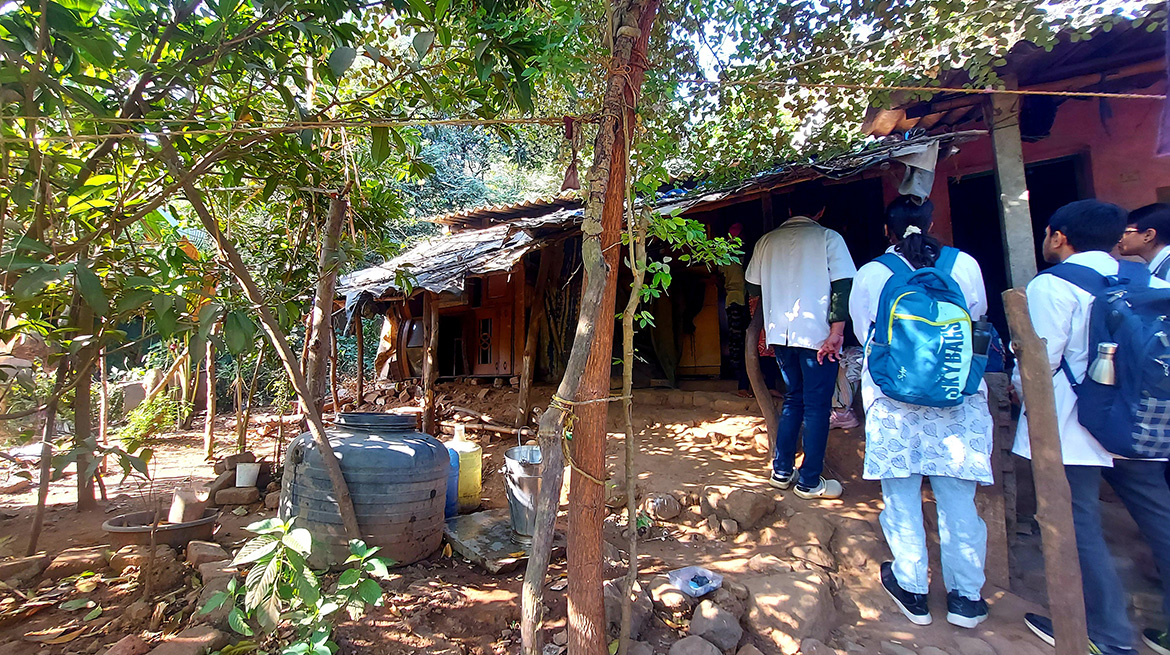‘A picture is worth a thousand words.’ How apt this sentence is. A picture describes what it would have taken a thousand words to narrate. Well, this is a blog, so I am supposed to use words rather than pictures, right? But I would rather take a complementary approach where words and pictures collide to create a holistic scenario. Afterall, in public health it is always about holistic vision, isn’t it? So let me take you through my lens of public health and let the flow of the words unfold the vista.
Field visits- seemingly ordinary but full of prospect of experiencing our subject first hand in real life scenario by the students. It is always a rewarding experience as an academician to see the young minds soaking in the community exposure with wonder (and some mischief too). Family Adoption Programme (FAP) mandated by the National Medical Commission (NMC) for the undergraduate medical students serves an excellent purpose of sensitizing students to the rural community, their health problems and observe health in a comprehensive manner in the homes of adopted families.
While accompanying the students in the villages of Southern Gujarat, some of the experiences got imprinted on my mind, which fortunately with today’s technology, I was able to preserve in visual formats to be shared with you all.
The majestic structure still standing proud with song of past singing beautifully with each passing year. This house belonged to a family of old aged parents, two married daughters, and a lovely dog. The head of the family used to work in a factory nearby the village and in his era, that factory was quite reputable, giving handsome salary to him. Unfortunately, that factory got closed due to some unforeseen reasons and he lost his job. Today he is living with meagre monthly pension of one thousand rupees. The pride of past luxury and wounds of present economic condition were clearly visible on the face of the head of the family while the students were taking information of their demographic profile. How unpredictable life is and how this changed socio-economic aspect could affect physical and psychological well-being was witnessed firsthand by the students while interacting with this family.

Smiling faces hide the most painful truths. This happy face of an elder grandmother was like a breath of fresh air on that hot sunny day. While talking with her, the students came to know that she had lost her husband, one son and younger son’s wife in past few years. That younger son had then married with a widow from other religion. The widow along with her daughters from previous marriage were living happily at present with this grandmother. Religion based divisions appear so clearly demarcated on social media, but in reality the students saw the divisions getting blurred or rather brushed away completely by that kind grandmother who wholeheartedly welcomed diverse family members in her life. On a side note, she was suffering from hypertension and complying to the prescribed drugs regularly and happily. Psychological health is intrinsically linked with physical health and compliance with health care services. Our students were fortunate to observe it with such beautiful life story of this family.

Life’s balance hangs extremely precariously. A single stroke and everything collapse. Students were quite astonished to hear the life story of this old man, living in this small house with his wife and mother. The man was almost 65 years of age. He suffered from injury to this right femur in an accident almost two decades ago. Initially he went to a private hospital for treatment, where he was advised for a surgery. But he said he was not satisfied with the way the doctor was managing his condition, so he took discharge against medical advice and came back home. He continued with traditional treatments for years, but his condition did not improve much. Finally, he got tired and left any sort of treatment completely. He is not able to support his weight on his legs and not able to walk at all. He was a small shopkeeper at a temple situated at nearby hill. As he can’t walk, his wife continued with the responsibility of running that shop, along with responsibilities of her husband and her older mother-in-law. Their married daughter living in the same village comes as often as she can to help her mother with the shop and household chores. Now the condition of that man was completely treatable, yet he chose to accept the fate of being disabled for life. Faith and beliefs could play role to what extent in a person’s life is a lesson that students experienced with their own eyes, something that even the best way of teaching in a classroom couldn’t have achieved fully.

Family- it may not be perfect, but its beauty lies in its strong bond. In this kachcha house, lived a man whose wife passed away few weeks ago. After his wife’s death he is living completely lonely. His daughters living in other villages had come with their children and were present in this house at the time of our visit. They were all for time being living with the father, looking after him and his house. There wasn’t much in that house except bare essential things but the family members accommodating so naturally the needs of the father at the crucial moment in life was really touching. The social and mental health components got addressed so effortlessly by these simple rural people, yet without seeking any external validation for their actions.

There are so many other experiences, but the gist of all remains same- life continues despite all hardships and it becomes easier if we have company. Let’s all continue to work together for better future, better health for all.




